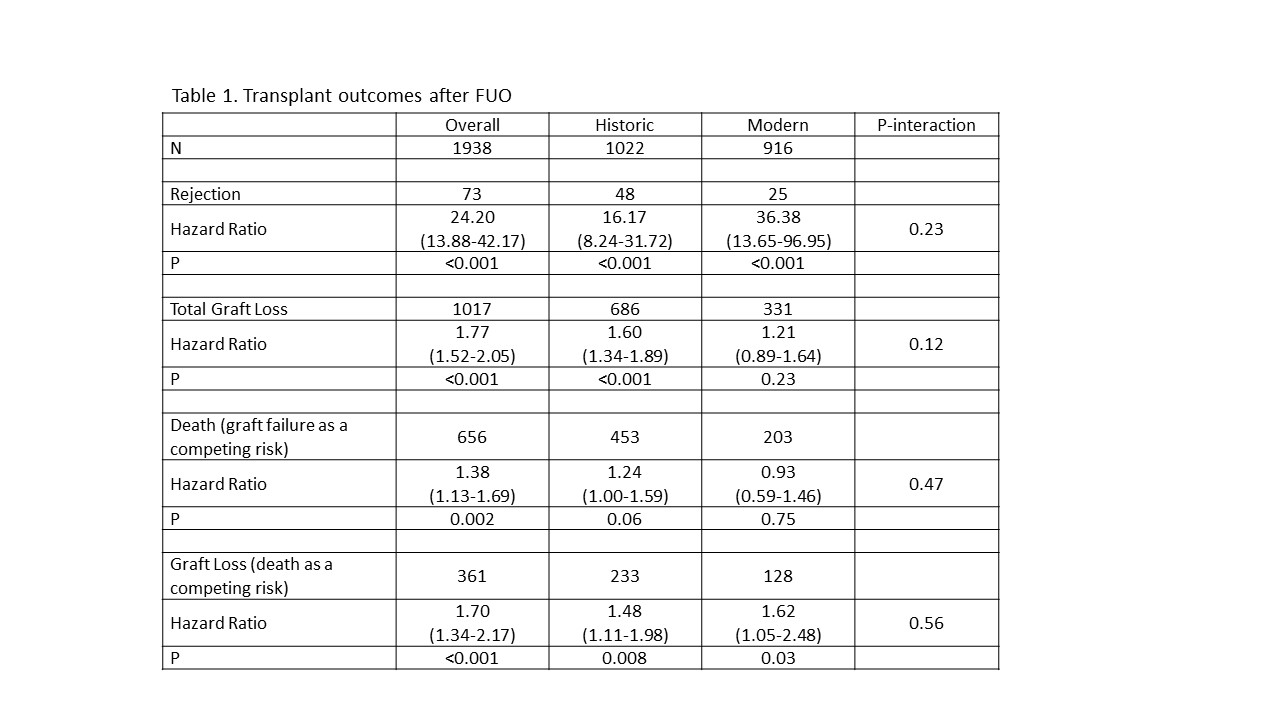Incidence and Outcomes of Fever of Unknown Origin After Kidney Transplant in the Modern Era
M. Jorgenson, S. Parajuli, B. Astor, C. Saddler, J. Smith, D. Mandelbrot
University of Wisconsin Health, Madison, WI
Meeting: 2022 American Transplant Congress
Abstract number: 552
Keywords: Infection
Topic: Clinical Science » Infection Disease » 25 - Kidney Infectious Non-Polyoma & Non-Viral Hepatitis
Session Information
Session Name: Kidney Transplant Infections
Session Type: Rapid Fire Oral Abstract
Date: Tuesday, June 7, 2022
Session Time: 5:30pm-7:00pm
 Presentation Time: 6:50pm-7:00pm
Presentation Time: 6:50pm-7:00pm
Location: Hynes Ballroom B
*Purpose: Fever is common in kidney transplant recipients (KTRs). If an etiology is not readily apparent, a patient can be classified as having a fever of unknown origin (FUO). In this study we aim to describe epidemiology and outcomes of FUO in KTRs in the modern era.
*Methods: KTRs between 1/1/1995 – 12/31/2018 were evaluated. The modern era was defined as 1/1/2006-12/31/2018 based on the availability of current-day molecular diagnostics, specifically CMV PCR, at our center. Patients were included if they had FUO as a coded diagnosis in our database. The primary objective of this study was to describe the epidemiology of FUO at our center over time. Secondary objectives were association of FUO with rejection, graft, and patient survival. Event density sampling was used to analyze post-FUO events, with 5 controls matched for deceased/living donor status sampled at the time of each FUO event.
*Results: There were 5,591 kidney transplants during the study window. FUO was an identified diagnosis in 320 patients for an overall incidence rate of 0.8/100 person-years; 204 before 2006 and 116 in the modern era. Median time from transplant to FUO across eras was 15.3 months (inter-quartile range [IQR]: 4.7, 56.5). The incidence of FUO in the first 3 years after transplant was significantly lower in the modern era than in the earlier period (n=212; Incidence Rate Ratio = 0.47; 95% CI: 0.35-0.63; p <0.001) A total of 102 (31.9%) of 320 FUO cases had an etiology determined within 90 days; 100 infectious and 2 malignancies. The causative infectious organisms were varied, but the most frequently identified in the historic era were candida species (n=15) and cytomegalovirus (n=14) and in the modern era Pseudomonas sp (n=9) and cytomegalovirus (n=9). Development of FUO significantly increased the risk of rejection (HR=24.2; 95% CI: 13.9-42.2; p <0.001), graft failure (HR=1.7; 95% CI: 1.3-2.2; p=0.03) and mortality (HR=1.8; 95% CI: 1.5-2.1; p<0.001). In the modern era FUO remained significantly associated with rejection (HR=36.4; 95% CI: 13.7-97.0; p< 0.001) and graft failure (HR=1.6; 95% CI: 1.1-2.5; p=0.03), but not total graft loss (HR=1.2; 95% CI: 0.9-1.6; p=0.23) or death (HR=0.9; 95% CI: 0.6-1.5; p=0.75; Table 1).
*Conclusions: The advent of molecular diagnostic testing has significantly reduced, but not eliminated, the diagnosis of FUO in KTRs. FUO remains significantly associated with rejection but does not appear to maintain the association with mortality and total graft loss that was present in the past. Scrutiny of immunosuppressive withholding in the setting of FUO is required, as diagnostic uncertainty wanes.
To cite this abstract in AMA style:
Jorgenson M, Parajuli S, Astor B, Saddler C, Smith J, Mandelbrot D. Incidence and Outcomes of Fever of Unknown Origin After Kidney Transplant in the Modern Era [abstract]. Am J Transplant. 2022; 22 (suppl 3). https://atcmeetingabstracts.com/abstract/incidence-and-outcomes-of-fever-of-unknown-origin-after-kidney-transplant-in-the-modern-era/. Accessed December 22, 2025.« Back to 2022 American Transplant Congress

